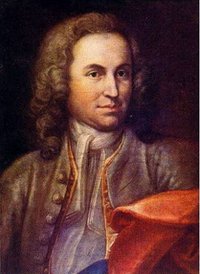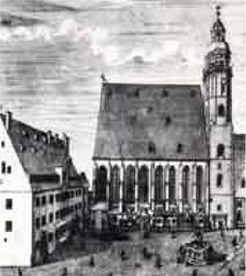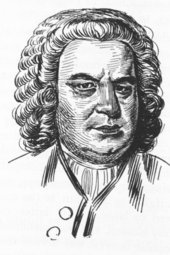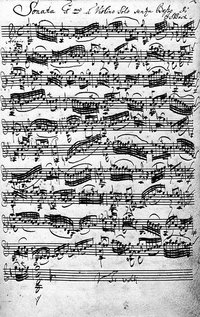Johann
Sebastian Bach (March 21, 1685–July
28, 1750) was a German composer and organist of the Baroque period,
and is almost universally regarded as one of the greatest composers
of all time. His works, noted for their intellectual depth, technical
command, and artistic beauty, have provided inspiration to nearly
every musician in the European tradition, from Mozart to Schoenberg.
Bach sheet music | Bach MIDI files | Bach recordings
Formative Years
J. S. Bach was born in Eisenach, Germany, in 1685. His father,
Johann Ambrosius Bach, was  the town piper in Eisenach, a post that
entailed organizing all the secular music in town as well as participating
in church music at the direction of the church organist, and his
uncles were also all professional musicians ranging from church
organists and court chamber musicians to composers, although Bach
would later surpass them all in his art. In an era when sons were
expected to assist in their fathers' work, we can assume J. S.
Bach began copying music and playing various instruments at an
early age.
the town piper in Eisenach, a post that
entailed organizing all the secular music in town as well as participating
in church music at the direction of the church organist, and his
uncles were also all professional musicians ranging from church
organists and court chamber musicians to composers, although Bach
would later surpass them all in his art. In an era when sons were
expected to assist in their fathers' work, we can assume J. S.
Bach began copying music and playing various instruments at an
early age.
Bach's mother died when he was still a young boy and his father
suddenly passed away when J. S. Bach was 9, at which time J. S.
Bach moved in with his older brother Johann Christoph Bach, who
was the organist of Ohrdruf in Germany. While in his brother's
house, J. S. Bach continued copying, studying, and playing music.
According to one popular legend of the young composer's curiosity,
late one night, when the house was asleep, he retrieved a manuscript
(which may have been a collection of works by Johann Christoph's
former mentor, Johann Pachelbel) from his brother's music cabinet
and began to copy it by the moonlight. This went on nightly until
Johann Christoph heard the young Sebastian playing some of the
distinctive tunes from his private library, at which point the
elder brother demanded to know how Sebastian had come to learn
them.
It was at Ohrdruf that Bach began to learn about organ building.
The Ohrdruf church's instrument, it seems, was in constant need
of minor repairs, and young J. S. Bach was often sent into the
belly of the old organ to tighten, adjust, or replace various parts.
Realizing that in the seventeenth and eighteenth centuries the
church organ, with its moving bellows, manifold stops, and complicated
mechanical linkages from the keys and pedals to the many actual
pipes, was the most complex machine in any European town, we can
imagine that Sebastian may have been awed by it much as modern
boys are fascinated by cars, trucks, and planes. This hands-on
experience with the innards of the instrument would provide a unique
counterpoint to his unequalled skill at playing the instrument;
J. S. Bach was equally at home talking with organ builders and
performers.
While in school and as a young man, Bach's curiosity compelled
him to seek out great organists of Germany such as Georg Böhm,
Dietrich Buxtehude and Johann Adam Reinken, often taking journeys
of considerable length to hear them play. He was also influenced
by the work of Nicholas Bruhns. Shortly after graduation (Bach
completed Latin school when he was 18, an impressive accomplishment
in his day, especially considering that he was the first in his
family to finish school), Bach took a post as organist at Arnstadt
in Germany in 1703. He apparently felt cramped in the small town
and began to seek his fortune elsewhere. Owing to his virtuosity,
he was soon offered a more lucrative organist post in Muhlhausen.
Some of Bach's earliest extant compositions date to this period
(including, according to some scholars, his famous Toccata and
Fugue in D Minor), but owing to the general immaturity of this "early" Bach
music, much of the music Bach wrote during this time has unfortunately
been lost.
Professional Life
Still not content as organist of Muhlhausen, in 1708, Bach took
a position as court organist and  concert master at the ducal court
in Weimar. Here he had opportunity to not only play the organ but
also compose for it and play a more varied repertoire of concert
music with the dukes' ensemble. A devotee of contrapuntal music,
Bach's steady output of fugues begins in Weimar. The best known
example of his fugal writing is probably The Well-Tempered Clavier,
which comprises 48 preludes and fugues, two for each major and
minor key, a monumental work not only for its masterful use of
counterpoint but also for exploring, for the first time, the full
glory of keys--and the means of expression made possible by their
slight differences from each other--available to keyboard musicians
when their instruments are tuned according to Andreas Werckmeister's
system of well temperament or similar system.
concert master at the ducal court
in Weimar. Here he had opportunity to not only play the organ but
also compose for it and play a more varied repertoire of concert
music with the dukes' ensemble. A devotee of contrapuntal music,
Bach's steady output of fugues begins in Weimar. The best known
example of his fugal writing is probably The Well-Tempered Clavier,
which comprises 48 preludes and fugues, two for each major and
minor key, a monumental work not only for its masterful use of
counterpoint but also for exploring, for the first time, the full
glory of keys--and the means of expression made possible by their
slight differences from each other--available to keyboard musicians
when their instruments are tuned according to Andreas Werckmeister's
system of well temperament or similar system.
Also during his tenure at Weimar, Bach began work on the Orgelbüchlein
for Wilhelm Friedemann. This "little book" of organ music
contains traditional Lutheran church hymns harmonized by Bach and
compiled in a way to be instructive to organ students. This incomplete
work introduces two major themes into Bach's corpus: Firstly, his
dedication to teaching, and secondly, his love of the traditional
chorale as a form and source of inspiration. Bach's dedication
to teaching is especially remarkable. There was hardly any period
in his life when he did not have a full-time apprentice studying
with him, and there were always numerous private students studying
in Bach's house, including such 18th century notables as Johann
Friedrich Agricola. Still today, students of nearly every instrument
encounter Bach's works early and revisit him throughout their careers.
Sensing increasing political tensions in the ducal court of Weimar,
Bach began once again to search out a more stable job conducive
to his musical interests. Prince Leopold of Anhalt-Cöthen
hired Bach to serve as his Kapellmeister, that is, director of
music. Prince Leopold, himself a musician, appreciated Bach's
talents, compensated him well, and gave him considerable latitude
in composing and performing. However, the prince was Calvinist
and did not use elaborate music in his worship, so that most
of Bach's work from this period is secular in nature. The Brandenburg
concerti, as well as many other instrumental works, including
the suites for solo cello, the sonatas and partitas for solo
violin, and the orchestral suites, date to this period.
 In 1723, J. S. Bach was appointed Cantor and Musical Director
of St. Thomas church in Leipzig in Germany. This post required
him to not only instruct the students of the St. Thomas school
in singing but also to provide weekly music at the two main churches
in Leipzig. Rising above and beyond the call of duty, Bach endeavored
to compose a new church piece, or cantata, every week. This challenging
schedule, which basically amounted to writing an hour's worth of
music every week, in addition to his more menial duties at the
school, produced some genuinely sublime music, most of which has
been preserved. Most of the cantatas from this period expound upon
the Sunday readings from the Bible for the week in which they were
originally performed; some were written using traditional church
hymns, such as Wachet auf! Ruft uns die Stimme and Nun komm, der
Heiden Heiland, as inspiration for the music.
In 1723, J. S. Bach was appointed Cantor and Musical Director
of St. Thomas church in Leipzig in Germany. This post required
him to not only instruct the students of the St. Thomas school
in singing but also to provide weekly music at the two main churches
in Leipzig. Rising above and beyond the call of duty, Bach endeavored
to compose a new church piece, or cantata, every week. This challenging
schedule, which basically amounted to writing an hour's worth of
music every week, in addition to his more menial duties at the
school, produced some genuinely sublime music, most of which has
been preserved. Most of the cantatas from this period expound upon
the Sunday readings from the Bible for the week in which they were
originally performed; some were written using traditional church
hymns, such as Wachet auf! Ruft uns die Stimme and Nun komm, der
Heiden Heiland, as inspiration for the music.
On holy days such as Christmas, Good Friday, and Easter, Bach
produced cantatas of particular brilliance, most notably the Magnificat
for Christmas and St. Matthew Passion for Good Friday. The composer
himself considered the monumental St. Matthew Passion among his
greatest masterpieces; in his correspondence, he referred to it
as his "great Passion" and carefully prepared a calligraphic
manuscript of the work, which required every available musician
in town for its performance. Bach's representation of the essence
and message of Christianity in his religious music is considered
by many to be so powerful and beautiful that in Germany he is sometimes
referred to as the Fifth Evangelist.
Family Life
Bach married his second cousin, Maria Barbara Bach, on October
17, 1707 after receiving a small inheritance. They had 7 children,
4 of whom survived to adulthood. Little is known of Maria Barbara.
She died suddenly on July 7, 1720 while Bach was travelling with
Prince Leopold.
While at Cöthen, Bach met Anna Magdalena Wilcke, a young
soprano. They married on December 11, 1721. Despite the age difference
(she was 17 years his junior), the couple seem to have had a very
happy marriage. Anna supported Johann's composing (many final scores
are in her hand) while he encouraged her singing. Together they
had 13 children.
All the Bach children were musically inclined, which must have
given the aging composer much pride. His sons Wilhelm Friedemann
Bach, Johann Gottfried Bernhard Bach, Johann Christoph Friedrich
Bach, Johann Christian Bach, and Carl Philipp Emanuel Bach all
became accomplished musicians, with C. P. E. Bach winning the respect
of Wolfgang Amadeus Mozart. Although the barriers to women having
professional careers were great, all of Bach's daughters most likely
sang and possibly played in their father's ensembles. The only
one of the Bach daughters to marry, Elisabeth Juliana Friederica,
choose as husband Bach's student Johann Christoph Altnickol. Most
of the music we have from Bach was passed on through his children,
who preserved much of what C. P. E. Bach called the "Old Bach
Archive" after his father's death.
At Leipzig, Bach seems to have fit in amongst the professoriate
of the university, with many professors standing as god-parents
for his children, and some of the university's men of letters and
theology providing many of the librettos for his cantatas. In this
last capacity Bach enjoyed a particularly fruitful relationship
with the poet Picander. Sebastian and Anna Magdalena also welcomed
friends, family, and fellow musicians from all over Germany into
their home; court musicians at Dresden and Berlin as well as musicians
including George Philipp Telemann (one of Carl Philipp Emanuel's
godfathers) made frequent visits to Bach's house and may have kept
up frequent correspondence with him. Interestingly, George Friedrich
Handel, who was born in the same year as Bach, made several trips
to Germany, but Bach was unable to meet him, a fact he regretted.
Later Life and Legacy
Having spent much of the 1720s composing weekly cantatas, Bach
assembled a sizable repertoire of church music that, with minor
revisions and a few additions, allowed him to  continue performing
impressive Sunday music programs while pursuing other interests
in secular music, both vocal and instrumental. Many of these later
works were collaborations with Leipzig's Collegium Musicum, but
some were increasingly introspective and abstract compositional
masterpieces that represent the pinnacle of Bach's art. These erudite
works start with the four volumes of his Clavier-Übung ("Keyboard
Practice") a set of keyboard works to inspire and challenge
organists and lovers of music that includes the 6 Partitas for
keyboard (Vol. I), the Italian Concerto, the French Overture (Vol.
II), and the Goldberg variations (Vol. IV).
continue performing
impressive Sunday music programs while pursuing other interests
in secular music, both vocal and instrumental. Many of these later
works were collaborations with Leipzig's Collegium Musicum, but
some were increasingly introspective and abstract compositional
masterpieces that represent the pinnacle of Bach's art. These erudite
works start with the four volumes of his Clavier-Übung ("Keyboard
Practice") a set of keyboard works to inspire and challenge
organists and lovers of music that includes the 6 Partitas for
keyboard (Vol. I), the Italian Concerto, the French Overture (Vol.
II), and the Goldberg variations (Vol. IV).
At the same time, Bach wrote a complete Mass in B Minor, which
incorporated newly composed movements with portions from earlier
works. Although the mass was never performed during the composer's
lifetime, it is considered to be among the greatest of his choral
works.
After meeting King Frederick II of Prussia in Potsdam in 1747,
who played a theme for Bach and challenged the famous musician
to improvise a six-part fugue based on his theme, Bach presented
the king with a Musical Offering including several fugues and canons
based on the "royal theme." Later, using a theme of his
own design, Bach produced The Art of Fugue. These 14 fugues (called
Contrapuncti by Bach), are all based on the same theme, demonstrating
the versatility of a simple melody. During his life time he composed
over 1,000 pieces.
Johann Sebastian Bach's contributions to music, or to borrow a
term popularized by his student Lorenz Christoph Mizler, "musical
science" are frequently compared to the "original geniuses" of
William Shakespeare in English literature and Isaac Newton in physics.
The BWV numbering system
 Johann Sebastian Bach pieces are indexed with BWV numbers, where
BWV is Bach Werke Verzeichnis . The catalog was compiled by Wolfgang
Schmieder and the BWV numbers are sometimes referred to as Schmieder
Numbers. An obsolete system uses S, instead of BWV, for Schmieder.
Johann Sebastian Bach pieces are indexed with BWV numbers, where
BWV is Bach Werke Verzeichnis . The catalog was compiled by Wolfgang
Schmieder and the BWV numbers are sometimes referred to as Schmieder
Numbers. An obsolete system uses S, instead of BWV, for Schmieder.
Johann Sebastian Bach pieces are indexed with BWV numbers, where
BWV is Bach Werke Verzeichnis . The catalog was compiled by Wolfgang
Schmieder and the BWV numbers are sometimes referred to as Schmieder
Numbers. An obsolete system uses S, instead of BWV, for Schmieder.
Further reading
* The early biography by Johann Nikolaus Forkel, from 1808, reprinted
in The Bach Reader (W. W. Norton, 1966), is of considerable value,
as Forkel was able to correspond directly with people who had known
Bach.
* The Bach Reader, edited by Hans T. David and Arthur Mendel, also contains
much other interesting material, such as a large selection of contemporary
documents, some by Bach himself.
* An early groundbreaking study of Bach's life and music is by Philipp Spitta:
Johann Sebastian Bach: Sein Leben etc..., Dover, 1951, ISBN 0-486-22278-0
* Another famous study of his life and music is J. S. Bach by the versatile
scholar and organist Albert Schweitzer, in two volumes (1908).
* Christoph Wolff's more recent works (Johann Sebastian Bach: The Learned Musician
and Johann Sebastian Bach: Essays), include a discussion of Bach's "original
genius" in German aesthetics and music.

